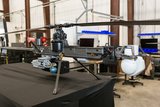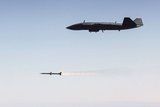AUVSI: Lockheed Martin shows off Samarai
The first public flight of the Samarai UAS, which resembles a 'winged seed', or samara, such as the seed of the maple tree, was conducted at Unmanned Systems North America on 16 August.
Lockheed Martin's Advanced Technologies Laboratories revealed the existence of the UAS at last year's conference, but could only show video of the system. Since then the team behind the design has continued to develop the UAS, which has its roots in biological design.
'There have been big improvements in the UAS, William Borgia, Director, Intelligent Robotics Laboratory told Shephard. 'We've been improving the control for stability and streaming video.'
Unlike a traditional aircraft the Samarai only has one control surface. That coupled with varying the power is the only way to guide it in flight. 'The only way we can do that is with intelligent control technology as a human operator wouldn't be able to control it,' stated Borgia.
Borgia believes a Samarai type UAS could have a number of applications. One possible use would be for urban surveillance. The design also means that the UAS could be dropped from altitude and auto-rotate in to position.
Although the current system has been developed largely so that the company's scientists can look at the issues of this type of control Borgia acknowledged that it would be possible to spin the UAS out in to a real product. 'We've been talking to other divisions in the company about its possible use,' he said.
Looking at the further development of Samarai Borgia said the design team would look at scaling the technology down. 'I'd like us to be able to do as well as nature can,' he added. However, shrinking the system down to the 5cm scale of a maple seed changes the control dynamics.
More from Uncrewed Vehicles
-
![What's next for the Pentagon after the Replicator programme?]()
What's next for the Pentagon after the Replicator programme?
Although the Replicator initiative has made several accomplishments, there are still multiple gaps to plug across the US Department of Defense (DoD) and its services.
-
![Cummings Aerospace showcases Hellhound loitering munition designed for US Army’s LASSO programme (video)]()
Cummings Aerospace showcases Hellhound loitering munition designed for US Army’s LASSO programme (video)
Cummings Aerospace presented its turbojet-powered Hellhound loitering munition at SOF Week 2025, offering a man-portable solution aligned with the US Army’s LASSO requirements.
-
![SOF Week 2025: PDW unveils attritable FPV drone for SOF operations at scale]()
SOF Week 2025: PDW unveils attritable FPV drone for SOF operations at scale
PDW has revealed its Attritable Multirotor First Person View drone at SOF Week 2025, offering special operations forces a low-cost, rapidly deployable platform for strike and ISR missions, inspired by battlefield lessons from Ukraine.
-
![SOF Week 2025: Teledyne FLIR white paper provides guidance on reusable loitering munitions]()
SOF Week 2025: Teledyne FLIR white paper provides guidance on reusable loitering munitions
Teledyne FLIR is highlighting the emerging requirements for 'recoverable and re-usable' loitering munitions across the contemporary operating environment during this week’s SOF Week conference in Tampa, Florida.
-
![SOF Week 2025: Kraken Technology group debuts K3 Scout USV in North America]()
SOF Week 2025: Kraken Technology group debuts K3 Scout USV in North America
High-performance maritime industry player Kraken Technology Group, based in the UK, has used the SOF Week conference in Tampa, Florida this week to debut its K3 Scout uncrewed surface vessel (USV) to the North American market.
-
![Palladyne AI and Red Cat to demonstrate capabilities for autonomous drone swarms to the US military]()
Palladyne AI and Red Cat to demonstrate capabilities for autonomous drone swarms to the US military
Red Cat and Palladyne AI recently conducted a cross-platform collaborative flight involving three diverse heterogeneous drones.

























